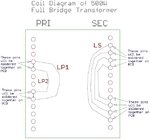Z
zenerbjt
Guest
Hi,
Just done the Transformer design for 500W Full Bridge with current doubler output.
Vin=400V
Vout = 24V
Pout = 500W
"Overall switching" frequency = 80kHz though primary magnetising current is like at 40kHz (as attached)
(Each diagonal FET pair switches at 40kHz, but together the two diagonal pairs of the bridge switch at 80kHz)
Even if I use the biggest offtheshelf core available (ETD59 by TDK), then I have a primary delta B which is going from +0.238T to -0.238T. This is too much. I am seeing 10W of loss in the core using N87 material, which is too much.
Do you know of any other bigger cores?
Attached is the PDF schem, the LTspice sim and the waveform shot showing primary current and primary magnetising current.
ETD 59 core datasheet
(EDIT................., ive just now increased the primary turns from 20 to 40, giving LP=8.48mH (and kept same NP/NS) and now am at +0.119T to -0.119T...still too much.....i dont want too much primary inductance otherwise the leakage inductance will be too big and i will "loose duty cycle" due to rise time of primary current being slowed. Actually, with LP=8.48mH i am getting 2.5W core loss with N87 material.)
Just done the Transformer design for 500W Full Bridge with current doubler output.
Vin=400V
Vout = 24V
Pout = 500W
"Overall switching" frequency = 80kHz though primary magnetising current is like at 40kHz (as attached)
(Each diagonal FET pair switches at 40kHz, but together the two diagonal pairs of the bridge switch at 80kHz)
Even if I use the biggest offtheshelf core available (ETD59 by TDK), then I have a primary delta B which is going from +0.238T to -0.238T. This is too much. I am seeing 10W of loss in the core using N87 material, which is too much.
Do you know of any other bigger cores?
Attached is the PDF schem, the LTspice sim and the waveform shot showing primary current and primary magnetising current.
ETD 59 core datasheet
(EDIT................., ive just now increased the primary turns from 20 to 40, giving LP=8.48mH (and kept same NP/NS) and now am at +0.119T to -0.119T...still too much.....i dont want too much primary inductance otherwise the leakage inductance will be too big and i will "loose duty cycle" due to rise time of primary current being slowed. Actually, with LP=8.48mH i am getting 2.5W core loss with N87 material.)
Attachments
Last edited by a moderator:
